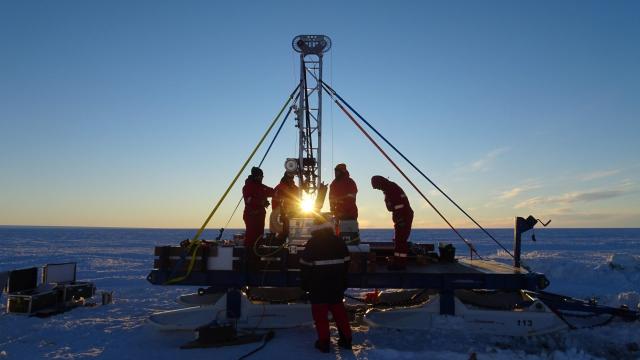Antarctica is often portrayed as a barren wasteland of ice and snow, about as inhospitable as any place on Earth. But a team of researchers just pulled up a huge amount of life from underneath the frozen continent, a testament to the tenacity of these extremophile organisms.
The life was found around 650 feet (200 meters) below the Ekström Ice Shelf, in waters that are 28 degrees Fahrenheit (minus-2 degrees Celsius) and pitch black. Seventy-seven different species of moss animals called bryozoans and worms were found, a veritable cornucopia of creatures that changes how researchers think of these extreme submarine environments. The team’s research was published this week in Current Biology.
“This has massively increased the known species from this least-known habitat,” David Barnes, a marine ecologist at the British Antarctic Survey, said in an email. Though some of the animals had already been found in other parts of Antarctica, the unusual habitat for this cache is a first. “This may give us clues into how life in polar seas survived glaciations,” Barnes added.
The environment is difficult to access, being beneath hundreds of feet of solid ice. To actually get a look at what dwells below, the research team bored a hole through the ice using a specialised hot water drill. Then, the team dropped cameras into the borehole. They also radiocarbon dated some of the bryozoan and bivalves they found, to see how long life had been there.
“Carbon dating of dead fragments of these seafloor animals varied from current to 5,800 years,” said co-author Gerhard Kuhn, an earth scientist at the Alfred Wegener Institute in Bremerhaven, Germany, in a British Antarctic Survey release. “So, despite living 3-9 kilometres from the nearest open water, an oasis of life may have existed continuously for nearly 6,000 years under the ice shelf.”

Life persevering in such extreme conditions is impressive. Some regions under the Antarctic ice have life, despite being in complete darkness for millennia. Some microbes subsist on pulverised bedrock that settles in the sediment beneath the continent. But larger organisms also manage to get by under unthinkable challenging conditions; a different team of biologists found sponges half a mile (1 kilometre) below Antarctica’s ice sheet, a discovery one of the researchers likened to “finding a bit of the rainforest in the middle of the Sahara.” Though the recent team’s discovery wasn’t as deep, it still expands the number of environments known to sustain life.
“There are many things we can learn from this unusual (and quite large) habitat,” Barnes said. “Many polar species can cope with much lower levels of food than thought (so although surface polar oceans are warming they may be able to survive in deeper (food-poor) waters.”
Despite how inaccessible the habitat is, though, it is changing along with the rest of the planet. As climate change warms the planet and hastens the collapse of Antarctic ice shelves, these pitch-black inland habitats could soon be exposed to the open ocean or be altered in other ways. Even if those changes could make some locations a happier home for photosynthesising creatures that can soak up the sun, the unique environment that currently exists under the Ekström ice shelf will be gone.
So far, only about 10 square feet (1 square metre) of the 620,000-square-mile (1.6-million-square-kilometre) habitat has actually been observed, leading to fears that some of the biodiversity under Antarctica could undergo anonymous extinction. “It is a major tragedy that one of Earth’s least known, disturbed and unique habitats could be lost before we even know it,” Barnes said. “There are likely to be many societally important answers to how our planet functions there.”
